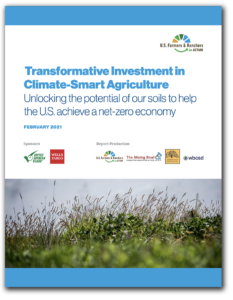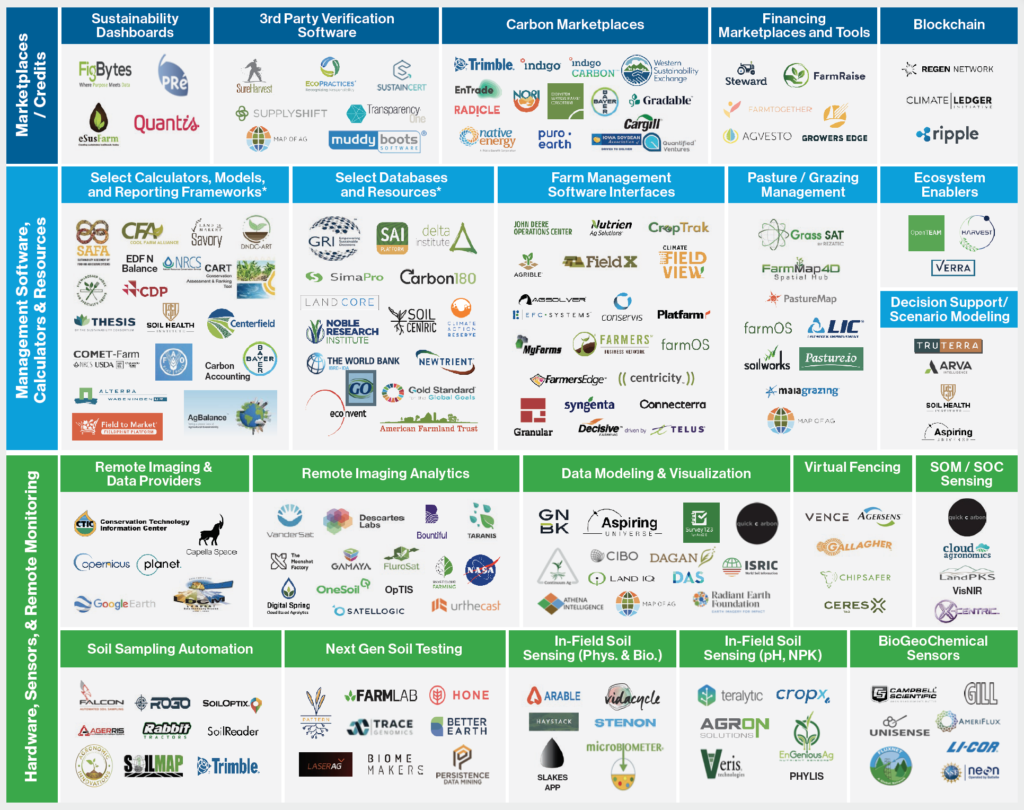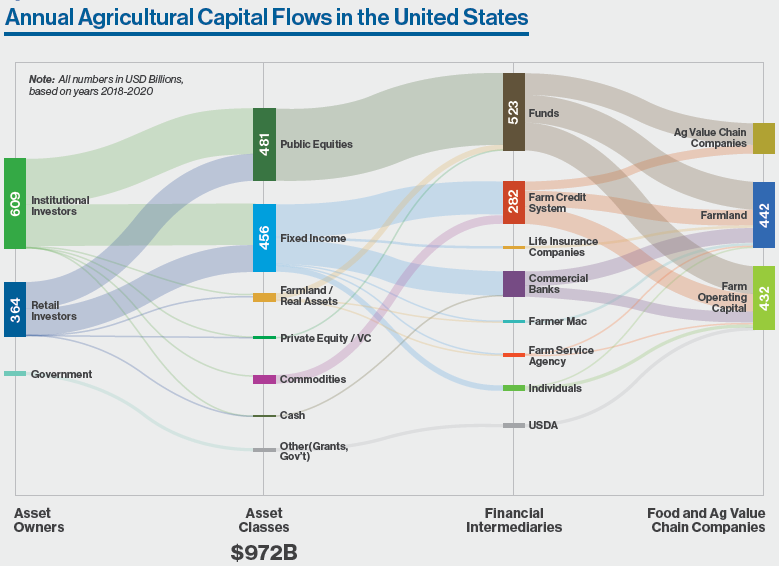Transformative Investment in Climate-Smart Agriculture: Introduction and Deep Dive
By: Megan Shahan
 A new U.S. Farmers and Ranchers in Action (USFRA) report, “Transformative Investment in Climate-Smart Agriculture: Unlocking the potential of our soils to help the U.S. achieve a net-zero economy” makes the case that increased attention and investment in agriculture is necessary and urgent. Why? Because scientific consensus is clear: global greenhouse gas emissions must be cut in half by 2030 and reach “net-zero” by 2050 to avoid more extreme impacts of climate change, including disruptions to food production, water supply, and global economies.
A new U.S. Farmers and Ranchers in Action (USFRA) report, “Transformative Investment in Climate-Smart Agriculture: Unlocking the potential of our soils to help the U.S. achieve a net-zero economy” makes the case that increased attention and investment in agriculture is necessary and urgent. Why? Because scientific consensus is clear: global greenhouse gas emissions must be cut in half by 2030 and reach “net-zero” by 2050 to avoid more extreme impacts of climate change, including disruptions to food production, water supply, and global economies.
This rapid timeline emphasizes the immediate need for significant emission reductions of all sectors, effective mitigation solutions, and increased investments in a net zero economy. According to the report, “U.S agriculture is a low-cost opportunity for all three.”
 The report states that regenerative, or climate-smart, farming and ranching practices adopted at scale have the potential to make U.S. Agriculture the first carbon negative sector in the economy (sequestering more carbon than it emits). Climate-smart practices, like cover crops, reduced or no-till crop rotations, managed grazing, compost application, and integrated crop and livestock systems, are currently practiced on a only fraction of the nearly 900 million acres of agricultural land in the United States.
The report states that regenerative, or climate-smart, farming and ranching practices adopted at scale have the potential to make U.S. Agriculture the first carbon negative sector in the economy (sequestering more carbon than it emits). Climate-smart practices, like cover crops, reduced or no-till crop rotations, managed grazing, compost application, and integrated crop and livestock systems, are currently practiced on a only fraction of the nearly 900 million acres of agricultural land in the United States.
First, let’s explore how it’s possible that agriculture can be “carbon negative” and what that actually means. Despite the potential to sequester carbon with management changes, the U.S. agriculture sector currently emits more greenhouse gas emissions (GHG) than it sequesters: the U.S. Agriculture sector accounts for nearly 10% of total U.S. GHG emissions. When management and production practices shift, en masse, to promote carbon sequestration and reduce greenhouse gas emissions wherever possible, the agriculture sector has the potential to be the only sector of the U.S. economy that naturally sequesters more carbon than it emits, thus becoming “carbon negative.”
To ground this exciting potential in science, the report explains that storing and cycling nutrients, such as carbon, nitrogen, and phosphorus is one of five essential functions of soil; other essential functions of soil are 1) regulating water 2) sustaining plant and animal life (including humans), 3) filtering and buffering potential pollutants, and 4) providing physical stability and support, both for plant roots and manmade structures.
Practices that promote healthy soils, therefore:
- Cycle nutrients effectively, storing carbon and nutrients in soil organic matter
- Provide good aeration to promote root growth
- Improve water storage and plant available water while protecting water quality
- Reduce runoff and erosion
- Reduce disease and pest problems
- Provide resilience to drought, heavy rainfall events, and temperature extremes
Taken together, these direct and indirect soil health outcomes improve yield stability and productivity thereby improving farm and ranch resiliency and profitability. When implemented at scale, improving soil health is a natural, cost-effective way to mitigate climate change.
So how do we transition to climate-smart agricultural practices at scale? And what are the current barriers to farmer and rancher climate-smart practice adoption? The report digs into both of these questions. One key tool is technology.
The rate at which new agricultural technologies are coming to market is staggering. These technologies offer a way for farmers and ranchers to collect data on their operations and benefit from machine learning (ML)/artificial intelligence (AI) to receive actionable insights and recommendations that optimize productivity, profitbilty, and sustainability. In the context of climate-smart, or regenerative, farming and ranching, technologies can allow land and livestock managers to monitor soil health outcomes, as well as crop livestock health and productivity.
However, as those who work in farming and ranching know, broad adoption of these technologies—often referred to as ‘the digitization of agriculture’—faces its own set of barriers. Barriers to digitization range from the basic lack of rural broadband access to the patchwork of data standards and interoperability (the ability to share and access data across platforms), as well as high costs and time required to input and organize data.
That said, there is significant motivation to overcome these barriers. In fact, the report states that “The digitization of agriculture may be the single biggest opportunity to meet farmers’ challenges and scale climate-smart soil practice adoption. Many of the economic, psychological, implementation, and external barriers to transitioning to climate-smart practices can be mitigated by more targeted, trusted, and easily collected information and metrics.”
With this in mind, the report authors analyzed over 150 climate-smart soil technologies—currently on the market—that support data collection and data connection, provide management insights, and unlock access to new markets (such as carbon markets). The Climate-Smart Soil Tech Landscape, below, offers a visual of some of the companies working in this space. The climate-smart soil technology analysis begins on page 27; investment recommendations on page 48.

Of the potential benefits of technology, the report explains, “The ability to model different operational or economic impacts based on different conservation decisions is central to understanding the risks and benefits of practice adoption. A combination of direct measurements (at the field/farm scale) and modeling (at larger spatial scales) can significantly aid in defining the efficacy of different practices in enhancing soil health. When layered with a Farm Management Software (FMS) solution to provide activity and temporal context, a practical decision framework for farmers and ranchers looking to implement climate-smart soil practices is possible.”
But this is about more than the profitability of any single farm or ranch (even though that challenge alone is enough to warrant its own 100 page report). This is about transforming our agricultural system to be resilient in the face of climate impacts and to mitigate climate change. It’s a task that requires the support, investment, and attention of a broad range of stakeholders. What if you really could help heal the planet with the food you eat?
Section two of the report examines the second key lever of this transformation: finance. Report authors found total capital flows into agriculture are valued at a whopping $972 billion; their analysis grouped capital flows by “Asset Owner” (institutional investors, retail investors, and government) and by “Asset Class” (public equities, fixed income, farmland / real assets, private equity / venture capital, commodities, cash, and other such as grants, or government). With this framework in place, they could then examine how different asset classes could be leveraged to “move capital from across financial value chains into climate-smart agriculture value chains in ways that would create positive impacts or to meet certain environmental, social, and governance (ESG) criteria.”

Bottom line: “The existing flows of capital need to be re-oriented toward climate-smart farming and ranching, and new capital needs to be brought in for those seeking to create positive impact or address ESG issues, particularly as it relates to broader national investments in a net zero economy.”
To read more on the analysis of capital flows into U.S. agriculture and financial mechanisms that are already working— or could be increasingly leveraged— to finance the transition to climate-smart agriculture, jump to page 52 of the report.
A key takeaway from this report is that agriculture must be included in the conversion and strategies for addressing climate change. Just as reducing fossil fuel emissions is necessary and urgent, agricultural practices that sequester excess atmospheric carbon and at the same time rebuild soil health, produce nutritious food and fiber, and revitalize rural communities are urgent and necessary. Farmers and ranchers need our support. There are small things each of us can do every day, like educating ourselves about climate change and how our food is grown, educating our friends and family, and ‘voting’ with our dollars by supporting local farms and ranchers who are responsible stewards of their land.